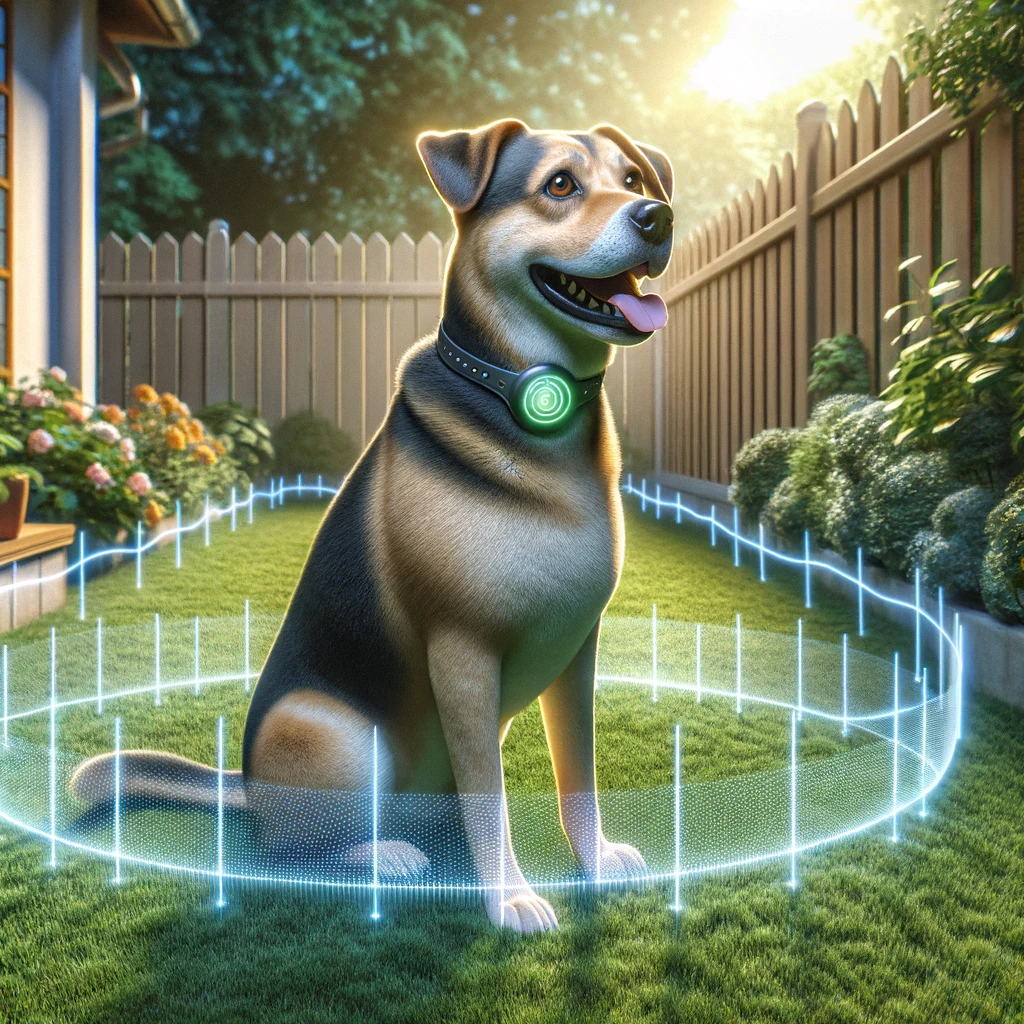When it comes to keeping your furry friend safe at home, traditional fences have been the go-to option for many years. However, with advancements in technology, wireless dog fences have become a popular alternative for pet owners.
These systems create an invisible boundary around your property, which helps prevent your dog from wandering off. By giving your pet the freedom to roam within a predefined space, you can enjoy the peace of mind knowing they’re secure.
All this without the visual obstruction or considerable expense of a physical fence.

Setting up a wireless dog fence is generally straightforward and can be a more flexible solution compared to traditional fencing.
After installation, training your dog to understand the boundaries is the next crucial step. With consistent training, your pet can learn to stay within the safe zone. This is often marked by warning beeps followed by a static correction from their collar if they attempt to cross the boundary.
Not only is this method reliable, but it also provides the safety your pet needs while offering them more liberty to play and explore.
Key Takeaways
- Wireless dog fences provide a secure boundary for your pet without the need for a physical barrier.
- Proper training is essential for your dog to respect the boundaries set by a wireless fence.
- These fencing systems offer a combination of safety, reliability, and peace of mind for pet owners.
- There are risks to consider with using an invisible dog fence, and debates about whether or not they are ethical or harmful to dogs
Wireless Dog Fences

Wireless dog fences provide a convenient way for you to keep your pet safe without the need for physical barriers. They rely on advanced technologies to create an invisible boundary that your dog learns to stay within.
The Technology Behind an Invisible Fence
Wireless pet fences operate primarily using radio frequency or GPS technology.
Radio frequency-based systems create a circular boundary around a central transmitter. If your dog approaches this boundary, their collar emits a warning signal followed by a mild electric stimulation to encourage them to return to the safe zone.
On the other hand, GPS technology-based fences, use satellites to establish a customizable perimeter.
It allows for a greater range and flexibility in defining boundaries, which is not limited to a circular area. These systems also tend to provide real-time tracking of your pet’s location.
Benefits of a Wireless Fence

Firstly, installation is a breeze; unlike traditional fences, there’s no need to dig or lay wires underground. It also means you don’t need to BUILD an actual fence, so it can be a much more budget friendly solution compared to a traditional barrier.
You can have the system up and running in no time, letting your dog roam freely within the set boundaries.
The ability to customize the containment area to fit the shape and size of your property is another key benefit.
Whether you have a small yard or a vast one, wireless fences are flexible:
- Portability: Easy to relocate with you, ideal for people who move frequently.
- Adjustability: Change boundary zones as needed.
A wireless dog fence fosters peace of mind. You can relax, knowing your pet is safely contained within your property, reducing the risk of them wandering off and encountering hazards.
If you have more than one dog, many wireless systems can accommodate multiple collars, making it easy to ensure that all your pets are secure and enjoying their freedom.
Additionally, they often come with safety features such as progressive corrections to gently remind your dog to stay within the safe zone.
Just think of it as an invisible barrier that’s always on guard, so you don’t have to be.
Risks of an Invisible Fence

Wireless dog fences are a modern solution for pet owners looking to keep their dogs safe within the boundaries of their property without the need for physical barriers. However, like any technology, they come with their own set of risks.
Here’s a closer look at a few things you might want to think about:
- Psychological Impact: The system works by delivering an electric shock when the dog approaches the boundary, which can potentially lead to stress or anxiety. It’s important to consider your dog’s temperament and how they might react to this type of training.
- Breach and Return Concerns: Highly motivated dogs might push through the boundary, especially if they’re chasing something. However, they may then be reluctant to cross back over the boundary due to the fear of receiving another shock, potentially leaving them stranded outside the designated area.
- No Physical Barrier for Others: Wireless fences effectively contain your pet, but they do nothing to stop other animals or people from entering your yard. This could potentially lead to encounters or conflicts that wouldn’t occur with a traditional fence.
- Learning Curve and Training Time: Wireless dog fences require consistent and proper training to be effective. Dogs may not immediately understand why they’re being corrected, leading to confusion and extended training periods.
- Dependence on Battery Life: The effectiveness of a wireless dog fence heavily depends on the battery life of the collar. If the battery dies and it goes unnoticed, dogs can easily wander beyond the set boundaries, posing a risk to their safety.
- Signal Interference: Invisible fences rely on a stable signal to operate effectively. Obstacles like large metal objects, dense foliage, or uneven terrain can interfere with the signal, which could allow a dog to cross the boundary without correction.
Controversy Surrounding Shock Training For Dogs
Obedience training through various dog shock collars is a highly debated topic among pet owners, veterinarians, and animal behaviorists. We elaborate on this at length in our article: Shock Collar for Dogs: Advice on Correction Techniques.
At the heart of the controversy is the use of electric shocks to modify a dog’s behavior, with proponents arguing that shock collars are effective for correcting unwanted behaviors when used correctly and humanely.
Critics, however, raise ethical concerns, highlighting the potential for pain, fear, and stress that can lead to behavioral problems and damage the bond between pets and their owners.
The discussion also delves into the variety of training methods available, advocating for positive reinforcement techniques as more compassionate and equally effective alternatives.
This ongoing debate underscores the importance of understanding the implications of training choices on animal welfare and the human-animal relationship.
PetMD, in an article about Invisible Fences For Dogs, say the following:
- “Invisible fencing systems rely on an electric shock to a dog’s neck that’s supposed to be painful enough that the dog doesn’t approach a defined boundary.
- There are many risks to using an invisible fence, including injury, behavior issues, and your dog escaping through the boundary.”
Selecting the Right Wireless Fence

In the realm of pet containment, a wireless dog fence is a blend of convenience and safety. Your aim is to keep your pet secure, while also providing them freedom within your property.
Factors to Consider
When you’re on the hunt for the best wireless dog fence, it’s crucial to weigh several factors to ensure you’re making a well-informed decision.
First up is range – you need to verify that the system’s boundaries can encompass the area you want to secure.
Remember, the greater the range, the more room your furry friend has to roam. It’s also important to focus on reliability, as you want a system that consistently operates without fail.
- Battery Life: Long-lasting battery prevents frequent recharging.
- Ease of Installation: Can it be set up without professional help?
- Adjustable Boundary: Can the perimeter be modified easily?
- Water Resistance: If your pet loves to swim, this is a must.
- Durability and weather resistance are also important, as your system will need to withstand the elements.
- Property Size: It’s essential to choose a system that can cover the entire area you want to secure.
- Consider the Landscape: Hills, metal objects, and thick foliage can disrupt the signal. Look for systems that are known to perform well in similar conditions to your own.
- Collar Features: Consider a collar that is waterproof, durable, and has adjustable correction levels.
- Installation Process: Make sure you’re comfortable with the installation process or that professional installation is available if needed.
- Read Reviews: Learning from the experiences of other pet owners can be invaluable. Look for reviews that address your specific concerns and don’t hesitate to ask your vet or a professional trainer for recommendations.
- Training Support: Ensure the product comes with clear training guidelines or support.
- Warranty and Customer Support: A good warranty and responsive customer support can be lifesavers if you encounter any issues with the system.
Installation Process

Setting up your wireless dog fence is usually straightforward and can be done with a few simple steps. Here’s how to get started:
Choose the Right Location for the Transmitter:
- Close to a power outlet
- Away from large metal objects
- Easy to access
For detailed instructions on installing the transmitter, see Dogs Alliance’s guide.
Install and Sync the Receiver Collar:
- Inserting batteries
- Testing the collar to make sure it syncs with the transmitter
For an example of inserting the batteries and syncing, refer to the tips on The Happy Hound Haven.
Set the Boundary Range:
- Adjust the settings on your transmitter
- Tune it to match the size of your yard
To test your wireless fence, simply walk the receiver collar up to the boundary you’ve set to ensure it beeps or performs the action that indicates the edge of the wireless fence.
And that’s it! Your wireless pet fence should now be active and ready to keep your furry friend safely contained within the bounds you’ve set.
Remember, a consistent training with your dog to recognize these boundaries will ensure the best success with your new wireless pet fence system.
Training Your Dog to Use the Fence

In order to ensure your dog understands and respects the boundaries set by a wireless fence, precise training and consistent reinforcement are key.
Patience and correct use of tools like a leash and training flags will help make this process smoother.
Steps for Successful Training
- Initial Introduction
Hang training flags near the boundary zone, giving a visual cue for your dog. Using a leash, walk your dog around the perimeter, letting them explore up to the flags. - Introduce Static Correction
Once your dog is familiar with the boundary, begin introducing static correction. Start with the lowest correction level and only increase if necessary. - Off-Leash Supervision
Gradually allow your dog to explore the boundary off-leash, but remain present to supervise. Correct any attempts to cross the boundary with a command and guide them back to safety. - Distraction Phase
Test your dog’s training by allowing distractions outside the fence perimeter. Stay vigilant to enforce the boundary rules if they become tempted.
Handling Stubborn Dogs
- Understand Your Dog
Some dogs are more headstrong and may require a firm yet patient approach. Understanding their personality can help tailor the training process. - Consistency is Key
Dogs thrive on consistency. Keep training sessions regular, using clear and consistent commands to reinforce the expected behaviors. - Adjust Correction Levels
Stubborn dogs might need a higher level of static correction. Monitor your dog’s response and adjust levels carefully to find the balance between effective training and your dog’s comfort.
Safety Features

When considering an invisible dog fence for your pet, safety is of paramount importance. The system should provide secure containment while ensuring the welfare of your dog.
Waterproof Collars
Most dogs love to explore, and sometimes that means getting wet. That’s where waterproof collars come in handy.
They are designed to withstand the elements, so whether your dog is splashing through puddles or getting caught in a rainstorm, the collar will keep functioning properly.
Each collar on the market has different waterproof ratings, so make sure to check that it matches your dog’s adventurous spirit.
Levels of Static Correction
The primary feature of a wireless dog fence is the static correction level. This is a mild electric shock that alerts your dog when approaching or crossing the designated boundary.
It’s crucial to look for a system that allows you to adjust the intensity of the static correction to suit your dog’s size, temperament, and learning process.
For your dog’s safety, it’s advised to start at the lowest level and increase gradually as needed. Remember to balance containment with compassion, always keeping your dog’s well-being in mind.
Adjustable levels of static correction provide a customizable training experience:
- Low: Best for initial training, sensitive or small dogs dogs.
- Medium: Ideal for teaching boundaries to average-sized dogs.
- High: Reserved for large or stubborn dogs familiar with the system.
Troubleshooting Common Issues

When dealing with wireless dog fences, you may occasionally run into a few hindrances that affect their reliability. The most common issues usually revolve around connectivity and the signal’s strength or weakness.
Understanding how to troubleshoot these problems can help maintain the integrity of your fencing solution.
The Pampered Pup, in their article on Common Wireless Dog Fence Problems, mention the following:
- Wireless dog fence systems usually rely on a wireless transmitter and a receiver collar, and even a small issue with either of those will prevent the whole system from functioning properly.
- They’re also quite vulnerable to outside factors, such as interference from the environment or even dogs not responding to the beeps and static correction.
- Fortunately most of them are fixable with a little patience and troubleshooting know-how.
Connectivity Problems
If you’re encountering connectivity issues with your wireless dog fence, verify that the collar is properly charged and that its battery is functioning well. Check that the collar is beeping correctly and responding to the fence boundary.
If the collar is charged but seems unresponsive, the issue may lie with signal interference from metal objects or electronic devices.
Try to grasp the basic layout of any potential interference sources in your yard and reposition the transmitter accordingly. A comprehensive guide to collar issues and signal interference can improve your understanding.
Weak Signal Correction
A weak signal in your wireless dog fence can manifest as a reduced range of operation or inconsistent correction. To enhance signal strength, first, verify that the transmitter’s power is fully charged or plugged into a working outlet.
It can be helpful to conduct a test walk of the fence boundary with the collar to check for any irregularities in signal strength along the perimeter.
Maintenance and Battery Life

Maintaining your wireless dog fence is crucial for ensuring your pet’s safety. Regularly checking and replacing batteries is part of this, as a reliable fence system hinges on consistent power.
You’ll be glad to know that most systems require no subscription fees, making them a cost-effective to traditional fencing.
Replacing Batteries
Your wireless dog fence runs on batteries, which will need replacing periodically.
Each manufacturer has specific recommendations for their product, but you can typically expect to replace collar batteries every 2 to 3 months.
Always check the product manual for your specific model’s guidelines!
Extending Battery Life
To ensure your wireless dog fence remains operational and your pet remains secure, there are steps you can take to extend the life of your batteries:
- Turn off the collar when not in use.
- Avoid leaving the collar out in extreme temperatures as both heat and cold can drain battery life.
- Regularly check the battery level; many collars have indicator lights or sound alerts when running low.
Conclusion

Wireless dog fences offer a balance of safety and freedom for your pet, allowing them to roam within set boundaries. These invisible fences are a less obtrusive option compared to traditional fencing and can be enhanced by technology such as GPS systems.
When you’re selecting a wireless dog fence, by considering the key factors outlined in this article, you’ll be well on your to finding the right one for you!
Remember to tailor your choice to your pet’s temperament and your property’s layout for optimal compatibility and maximum effectiveness.
One of the most important factors is committing to training your pet patiently and gently to understand their new boundaries is crucial for a successful transition.



